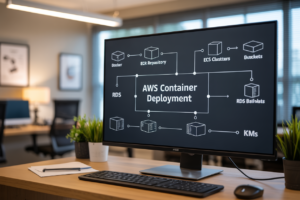Ever shipped code to production only to watch it crash spectacularly? Yeah, me too. That stomach-dropping moment when you realize your “minor update” just took down the entire checkout system.
What if you could deploy new features with zero panic attacks? That’s the magic of feature flags – they’re revolutionizing how smart teams roll out code.
Feature flags act like light switches for your code, letting you control exactly who sees what and when. Turn features on for 2% of users, specific regions, or just your QA team while keeping them invisible to everyone else.
But here’s what most developers miss about feature flags: they’re not just safety nets. They’re strategic weapons that completely transform your deployment workflow. And the best part?
What Are Feature Flags?
Definition and Basic Concept
Ever been nervous about pushing new code to production? Feature flags are your safety net. Think of them as on/off switches you build into your code that control whether specific features are visible to users.
They’re simple but powerful: wrap a feature in a conditional statement that checks if the flag is “on” or “off.” When off, users never see the feature. When on, it’s live.
What makes them so useful? You can deploy code without actually releasing the feature. The code sits dormant until you’re ready to flip the switch.
How Feature Flags Work in Code
Here’s how simple it really is:
if (featureFlags.newCheckoutProcess === true) {
// Show the new checkout process
renderNewCheckout();
} else {
// Show the old checkout process
renderOldCheckout();
}
No rocket science here. Just a conditional statement checking a configuration value.
The magic happens in how you manage these flags. Modern systems store them outside your code in management platforms that let you toggle features without deploying again.
Types of Feature Flags (Permanent vs. Temporary)
Feature flags come in two main flavors:
| Type | Purpose | Lifespan |
|---|---|---|
| Temporary | For safe rollouts, A/B testing, canary releases | Removed after full deployment |
| Permanent | Long-term toggles for subscription tiers, regional features | Stay in codebase indefinitely |
Temporary flags should be cleaned up regularly—they’re technical debt waiting to happen.
Real-world Examples of Feature Flag Implementation
Netflix uses feature flags to test streaming algorithms on small user groups before rolling them to everyone.
Facebook continuously ships new features behind flags, gradually exposing them to increasing percentages of users while monitoring performance metrics.
GitHub uses flags to enable enterprise features for paying customers while keeping them invisible to free users—all from the same codebase.
Many companies implement progressive feature rollouts, starting with 1% of users and scaling up as confidence builds.
Benefits of Using Feature Flags
A. Reducing Deployment Risk
Feature flags are your deployment safety net. Instead of the nail-biting, all-or-nothing deployments, you can ship code that remains dormant until you flip a switch. Found a bug? Just turn the feature off. No panic-inducing rollbacks or emergency fixes at 2 AM.
This approach lets your team push code regularly without the usual stress. The code sits quietly in production, invisible to users until you’re 100% confident it’s ready for showtime.
B. Enabling Continuous Delivery
The old way: build features for weeks (or months), then pray everything works when you finally release.
The feature flag way: ship code in small chunks, keep features hidden, and release them when they’re ready.
Your developers can work on features without waiting for the entire feature to be complete. They merge code daily while keeping it invisible to users. This workflow prevents the notorious “integration hell” and keeps your codebase fresh.
C. Facilitating A/B Testing
Gone are the days of guessing what users want. With feature flags, you can show different versions of a feature to different user segments and measure which performs better.
Want to test a new checkout flow with 5% of your users? Feature flags make it simple. You can compare user behavior, conversion rates, and gather real data before committing to changes.
D. Supporting Canary Releases
Progressive rollouts are a game-changer for risk management. Start by showing your new feature to just 1% of users, then 5%, then 20%… you get the picture.
If metrics look good, keep expanding. If not, roll back instantly without affecting everyone. This gradual approach catches issues early when they impact fewer users.
E. Empowering Non-Technical Teams
Product managers and marketers don’t need to file tickets and wait for deployment windows anymore. With feature flags, they can control feature releases themselves through simple interfaces.
Want to launch that new feature right after the press announcement? Toggle it on. Need to coordinate a release with a marketing campaign? Schedule the flag to turn on automatically.
This independence accelerates decision-making and removes engineering bottlenecks that traditionally slow down business initiatives.
Implementing Feature Flags in Your Development Workflow
Technical Considerations
When you start implementing feature flags, you’ll need to tackle a few technical challenges head-on. First, decide where to store your flag configurations. Many teams start with a simple JSON file, but as you scale, you’ll want a database solution that can handle concurrent updates and provide historical tracking.
Code organization matters too. Don’t scatter flag checks throughout your codebase—it’ll become a maintenance nightmare faster than you can say “technical debt.” Instead, create a dedicated service layer that handles flag evaluation, keeping your application code clean.
Remember that feature flags create branches in your code execution path. Each additional flag doubles your possible code paths, so be strategic about what gets flagged. Not every feature needs a toggle!
Choosing a Feature Flag System
You’ve got options. Lots of them.
For smaller teams, open-source solutions like Unleash or Flagsmith give you solid control without breaking the bank. Larger organizations often gravitate toward commercial platforms like LaunchDarkly or Split, which offer robust management interfaces, user targeting, and analytics.
| System Type | Good For | Examples |
|---|---|---|
| DIY | Complete control, simple needs | Custom JSON/DB solution |
| Open Source | Balance of control & features | Unleash, Flagsmith |
| Commercial | Enterprise needs, advanced targeting | LaunchDarkly, Split |
Pick a system that matches your team’s scale and requirements. Don’t overengineer from day one, but choose something that can grow with you.
Integration with CI/CD Pipelines
Feature flags shine brightest when they’re baked into your CI/CD pipeline. The magic happens when new code protected by feature flags can sail through to production without separate release branches.
Start by automating flag creation as part of your build process. When a developer creates a new feature branch, have your pipeline generate a corresponding feature flag.
Next, wire up your deployment tools to automatically toggle flags for canary releases or percentage-based rollouts. This lets you incrementally expose new features to growing segments of your user base while monitoring for issues.
Some teams go a step further—automatically rolling back flags when monitoring detects problems. That’s the continuous delivery dream: deploying constantly but releasing thoughtfully.
Best Practices for Feature Flag Management
A. Naming Conventions
Ever tried to decipher what “flag_23” actually controls? Yeah, not fun.
Good feature flag names should tell you three things at a glance: what feature they control, their purpose, and their scope. I recommend using a consistent format like [area]_[feature]_[purpose]:
checkout_digital_wallet_enable
user_profile_dark_mode_beta
pricing_new_algorithm_rollout
This naming structure makes it instantly clear what each flag does, saving your team countless hours of confusion and Slack messages asking “what’s this flag for again?”
B. Documentation Requirements
Feature flags without documentation are like roads without signs – technically usable but guaranteed to cause accidents.
For each flag, document:
- The flag’s purpose (what it enables/disables)
- Who owns it (team or individual)
- When it was created
- Expected lifespan (temporary or permanent)
- Current status (testing, rollout, fully deployed)
Keep this documentation where developers actually look – in your code repository or feature flag management system, not buried in some wiki nobody visits.
C. Cleaning Up Obsolete Flags
Feature flag debt is real, and it’s just as problematic as technical debt.
Old flags clog your codebase and create branching complexity that makes testing nearly impossible. Implement a regular “flag cleanup day” where teams review and remove obsolete flags.
Set expiration dates for temporary flags when you create them. Most feature flag tools let you do this automatically. When a flag reaches its expiration date, you should get an alert to either extend it (with justification) or remove it.
D. Testing Strategies with Feature Flags
The power of feature flags really shines in testing. You can:
- Test both flag states (on/off) in your CI pipeline
- Run end-to-end tests with different flag configurations
- Create test environments with specific flag combinations
This approach catches those “works in my environment” bugs before they reach production.
For complex systems, create a flag matrix that maps which tests should run for which flag combinations. This might seem like overkill, but it’s saved my team from countless late-night debugging sessions.
Common Challenges and Solutions
A. Technical Debt from Abandoned Flags
You know that feeling when you clean out your garage and find stuff you forgot about? That’s what happens with feature flags when teams don’t clean up after themselves.
Forgotten flags pile up in your codebase like digital dust bunnies. Every abandoned flag adds complexity, making your code harder to understand and maintain. The solution? Set expiration dates on temporary flags from day one. Some teams even create “flag parties” where they spend an afternoon hunting down and removing outdated toggles.
Smart teams use automated tools to track flag usage and alert them when flags haven’t been toggled in months. Remember: a good feature flag system includes a retirement plan.
B. Performance Implications
Feature flags aren’t free – they cost computing resources. Each flag evaluation adds a tiny performance hit. One or two? No big deal. Hundreds in a critical path? Now we’re talking problems.
To minimize impact:
- Cache flag decisions where possible
- Evaluate flags once per user session, not on every action
- Use flag hierarchies to reduce evaluation frequency
// Instead of this (evaluates twice)
if (isFeatureEnabled('new-header')) { ... }
if (isFeatureEnabled('new-header-logo')) { ... }
// Do this (evaluates once)
if (isFeatureEnabled('new-header')) {
const useNewLogo = isFeatureEnabled('new-header-logo');
...
}
C. Handling Configuration Conflicts
When multiple teams manage flags independently, conflicts happen. Two teams might create flags with identical names but different purposes, or worse – conflicting settings.
Establish a naming convention that includes team ownership (e.g., team-feature-purpose). Create a registry of active flags with clear ownership documentation. Build validation steps into your deployment pipeline to catch conflicts before they reach production.
D. Managing Flag Dependencies
Flag dependencies are tricky beasts. Feature A depends on Feature B, which depends on C – suddenly your simple flag becomes a complex web.
Draw dependency maps for complex features. Document relationships between flags in your flag management system. Test all possible flag combinations during development – don’t assume users will only experience your “happy path” configuration.
Smart teams build circuit breakers that automatically disable dependent features when a parent feature is turned off, preventing half-implemented experiences from reaching users.
Advanced Feature Flag Strategies
Progressive Rollouts Based on User Segments
Feature flags aren’t just on/off switches – they’re surgical tools. Want to avoid that dreaded “everyone’s site is down” scenario? Start by rolling out features to 5% of your user base, then 10%, and so on.
The real magic happens when you segment strategically:
- Roll out to internal users first (they’re forgiving)
- Target power users who’ll give honest feedback
- Segment by geography to manage load spikes
- Filter by subscription tier (premium users get goodies first)
This approach turns potential disasters into controlled experiments. When that new notification system has a memory leak, only your beta testers will notice – not your entire customer base.
Using Feature Flags for Kill Switches
Picture this: your payment processing module goes haywire at 2 AM. With a kill switch flag, you can instantly disable just that component while keeping the rest of your app running smoothly.
Smart teams build kill switches for:
- CPU-intensive operations
- Third-party integrations
- New algorithms
- Payment flows
One fintech company I know avoided a $2M disaster by flagging their new transaction processor. When it started duplicating charges, they flipped one switch instead of rolling back their entire deployment.
Feature Flags in Microservices Architecture
Microservices and feature flags were made for each other. When you have dozens of services communicating, coordinated rollouts become nightmarishly complex.
With feature flags, you can:
- Deploy new service versions behind flags
- Control which services see new API versions
- Run compatible versions in parallel during transition
- Gradually shift traffic between implementation variants
This solves the classic “deploy everything at once” problem that haunts microservice teams. Instead of synchronized deployments across 20 services, each team can deploy independently while maintaining compatibility.
Integrating Analytics with Feature Flags
The smartest teams don’t just deploy with feature flags – they measure everything.
Connect your analytics to your flag system to discover:
- How feature adoption differs across user segments
- Which features actually improve your core metrics
- Where users struggle with new interfaces
- Performance impacts on different devices/browsers
This isn’t just about catching bugs – it’s about understanding value. One e-commerce client found their fancy new recommendation engine (which took 6 months to build) actually decreased purchases by 3%. Without feature flags tied to analytics, they’d never have known.
Automating Feature Flag Operations
Manual flag management doesn’t scale. Once you have more than a dozen flags, automation becomes essential.
Build systems that:
- Auto-clean expired flags (flag debt is real)
- Gradually increase rollout percentages based on error rates
- Automatically revert when metrics cross warning thresholds
- Schedule flag transitions for low-traffic periods
The most sophisticated teams even use machine learning to determine optimal rollout speeds based on usage patterns and system health metrics.
Feature flags represent a powerful tool that transforms how development teams deploy and manage software features. By enabling gradual rollouts, seamless A/B testing, and risk mitigation through controlled releases, they’ve become essential for modern software delivery. When implemented correctly within your development workflow and managed according to best practices, feature flags can significantly enhance your deployment strategy while reducing potential complications.
As you incorporate feature flags into your projects, remember that the initial complexity pays dividends in flexibility and safety. Start small with a focused implementation, establish clear naming conventions, and build proper governance processes. With experience, you can evolve toward more sophisticated strategies like targeted rollouts and experimentation. Whether you’re a small startup or an enterprise organization, feature flags offer a practical approach to delivering software with greater confidence and responsiveness to user needs.




















